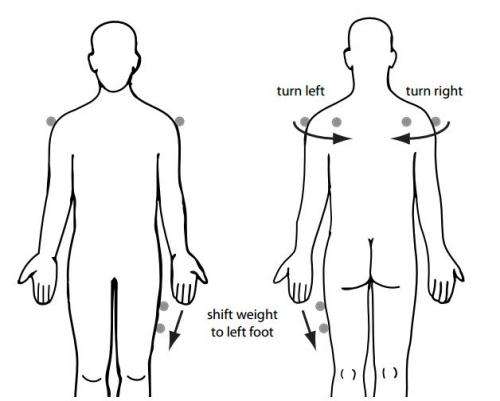December 23, 2012 report
Snowboarders feel the buzz from haptic system

(Phys.org)—Daniel Spelmezan, an engineer at the Université Paris-Sud, has worked on a snowboard system that might lighten the case loads of orthopaedic surgeons and even keep those packets of Advil from being emptied. Spelmesan is behind a haptic snowboarding concept that uses vibrations to help teach the sport to new enthusiasts by sending cues to their limbs to execute moves properly. The system involves sensor-equipped snowboards and suits.
Can tactile instructions in the form of vibrating actuators for arms and legs guide successful movements? Does such a system match or even outperform lessons in the usual way, where the only training comes from a coach, who delivers instructions and comments before and after the ride?
He looked for answers in the context of snowboarding in a test at an indoor ski resort with ten amateur snowboarders and a snowboarding instructor. The volunteer instructor tested moves involved, such as turns, riding switch, and carving, to confirm that the system functioned as intended
Participants got two lessons, one with and one without the sensors. They went downhill using turns that involved shifting weight and direction to zig-zag in an S-shaped pattern down. Mounted sensors on the snowboards sensed which way the boarders faced when they traveled down the slope, and when they turned to face the other way and continue their way down. The run up to the turn triggered the sensors to buzz in sequence, to remind the participant about which bits of the body to bend or where to shift weight.
Two vibration motors were placed around each shoulder and laterally at the thigh that pointed forward during the ride.
The tactile instructions were most effective when the exercises were not too difficult. When the snowboarders practiced new and difficult exercises, however, they focused on the coach's instructions and had a hard time paying attention to tactile instructions.
Some said the vibrating guides were a distraction. Only when a move became familiar did the buzzing help out, as reminders of the kinds of postures they needed to keep. In other words, they found the system useful in refining their techniques after first trying out new moves a few times. One such test participant reported, "I did not really react to the tactile instructions, although I noticed them, because there were so many other things to think about."
Spelmezan presented his work at the MobileHCI (focused on human computer interactions with mobile devices) conference earlier this year. The paper, "An Investigation into the Use of Tactile Instructions in Snowboarding," reported what the snowboarders said about their tests, and presented recommendations for the use of tactile instructions in teaching sports skills.
The Spelmezan system is based on an Arduino BT (an Arduino board with built-in Bluetooth module for wireless communication) and a Nokia N70 mobile phone as the host device. The system was programmed to detect the point when the rider pivoted the snowboard from one edge to the other edge. Pressure sensors measured the rider's weight distribution on the snowboard.
Vibrating sensors on the body, triggered by motion sensors in the snowboard, could remind snowboarders if they used the wrong turning technique on the slopes. Stimuli at the thigh signaled to shift the weight to the front foot, and stimuli at the shoulder signaled to turn left or right.
But were the test participants paying attention? Those snowboarders with no experience focused on the coach's words. Those with some experience were able to follow both tactile instructions and spoken instructions. Tactile instructions proved to be a good support for the learner fine-tuning previously learned movements."
"Based on our findings, we conclude that tactile instructions should not be applied during the first lessons or when the coach introduces new exercises," the paper stated.
"Tactile instructions should be introduced after the learner has acquired the basic skills in performing the new task. At this stage during training, the cognitive load on the learner will be lower."
The most common snowboard injury is to the wrist. A common injury scenario is falling onto an outstretched hand.
More information: hal.inria.fr/hal-00744527/
© 2012 Phys.org


















